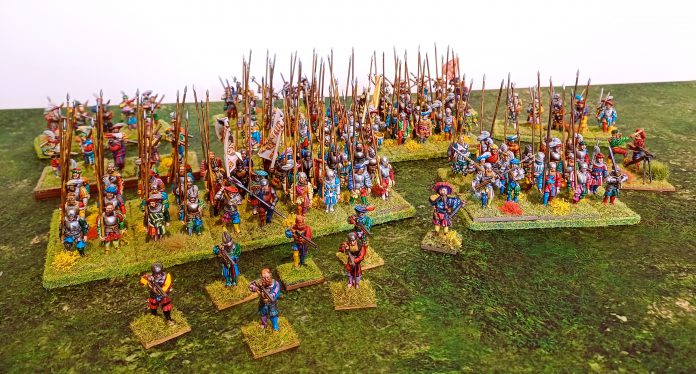In this army showcase I want to take you on a virtual brain tour of one of the most interesting periods of time, which incidentally has an absolute amount of drip. And how I accidentally tripped into it. You see, the models portrayed here are actually fellow contributors and all around nice person Lupe, who had (and probably has) an overabundance of models clogging up his cabinets. At the time it seemed a good idea to help by unburdening him from some irksome pikemen, and suddenly I was awash in landsknechts, with a solid helping of late medieval troops. This posed a problem as my knowledge of the period was rather vague at the time, but an army like that contained Pikes, a lot of them in fact, and who can resist that, really. At the time I also recently finished two small forces for the Thirty Years War, so I was already on the pike-induced mania like some sort of WWE wrestler, but a lot quieter and with less ripped shirts.
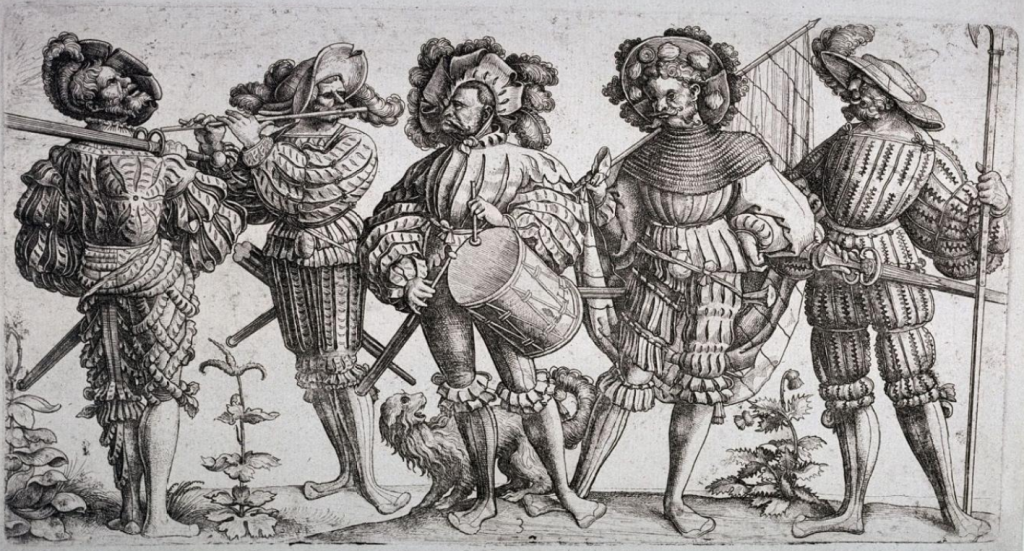
After receiving the meticulously packed little dudes, I took stock and was overcome by that familiar rush of mild panic, guilt, shame and despair as you suddenly realize you will have a lot of painting and reading to do, and the internet will laugh at you if you get something wrong. At that point I didn’t even have an appropriate ruleset, a clear example of a rational decision to do a little late medieval/early renaissance project and thinking you can just grind that out. The packet consisted of a healthy mix of Warlord and Perry plastics, a handful of metal leader models and a whole bunch of bases, as well as 3D printed movement trays. That pit in your stomach after a good/stupid decision? Imagine it growing after seeing a few of Lupe’s painted models. It set a standard. But outwardly undeterred, I set to work.
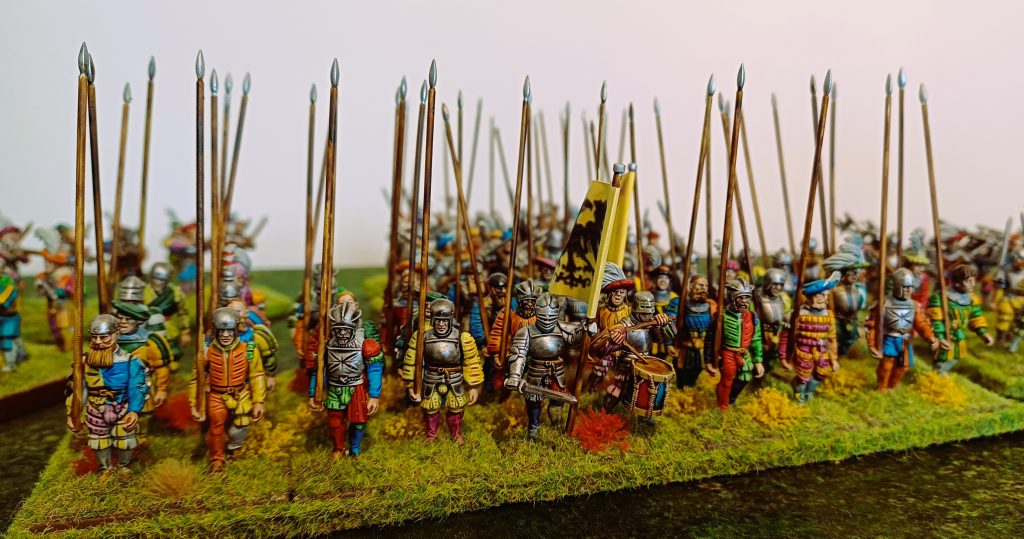
First things first: the history. I set out to get some Osprey books about the period (roughly late 1400’s -1600’s) which would serve as primers so I could get a better grip on this piece of history. I love Ospreys for this. They’re clear, won’t get you bogged down in too much detail, and because they’re so specific, give a great overview. Because we’re also living in the future but less exciting and a bit more depressing than we want it to be, I also used as many online resources as I could. I don’t think you have to actually do this if you’re playing historicals by the way. Enjoying these games and models doesn’t have to be homework if you don’t enjoy it. But I like reading and I’ve never encountered a period of history that wasn’t interesting for some reason. This is why I also enjoy going out sometimes to stare at a field and go “wow, cool” because something interesting happened there 500 years ago.
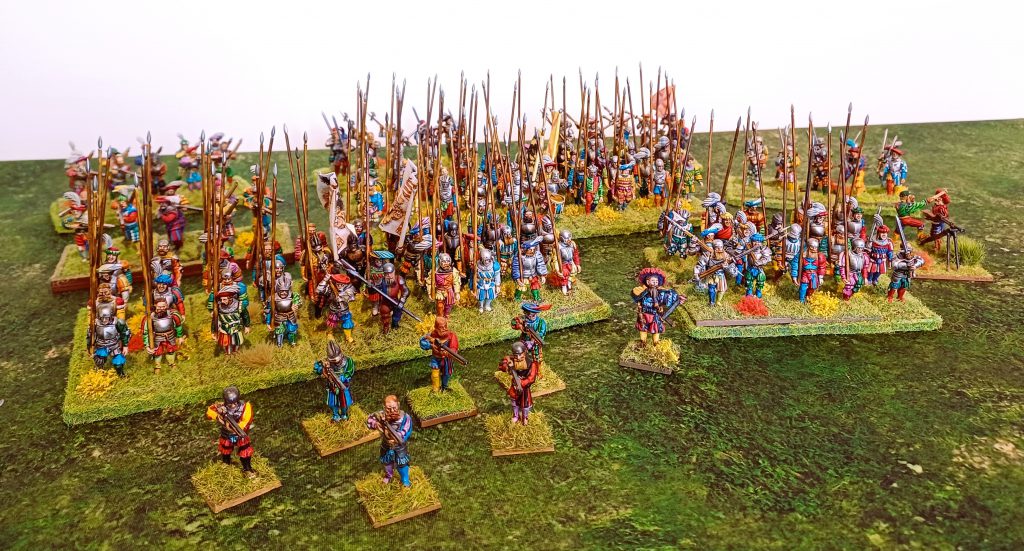
As far as interesting periods go, Italy and Habsburg Europe in the timeframe has plenty going for it. The bulk of my army would consist of Landsknechts, probably the most renowned and infamous example of professional mercenaries who made Europe their playground and were rightly feared for their vicious fighting. The first companies were raised by order of Emperor Maximilian I after he was declared king of Germany. This was in direct response to conflicts involving well-trained and motivated Swiss pikemen, who racked up victory after victory during the Burgundian wars. Turns out that if you train people who have a reason to fight (money), this pays off. Another factor is the decline of the armored knight. Heavy cavalry started to have real problems with massed pike blocks, and are noticeably more expensive than what is basically a guy with a pointy stick. The first Landsknecht regiment was raised in Bruges, incidentally, by Count Eintelfritz Von Hohenzollern, a name so German there must be sauerkraut involved somewhere. Assisted in their training by Swiss consultants, they booked their first successes in the low countries, leading to an expansion of the system. By only hiring from his own territories, Maximilian wanted to create a loyal force of mercenaries, which he later learned would be a contradiction, as religious tensions and lack of pay would divide the troops and incite mutiny.
For a wargamer all this grief is actually good news, since mercenaries will work for anyone, and you don’t even have to change up banners in some cases. The second thing you’ll want to know is how to paint these guys of course. The good news is that we’re looking at a period 500 years in the past, so we’ve got some leeway in that regard. Also: Landsknechts are famous for being flamboyant, and on special dispensation from Maximilian, were allowed to wear whatever they wanted, since they were almost certainly doomed for a short, hard life as mercenaries. Nuance not being one of the strongpoints of these guys, they went all-out. Uniformity is actually discouraged, as most Landsknechts would spend their money on drink, women and fancy clothes. This gives you an exciting opportunity to step out of the grim darkness or boring shades of green and into a multi-colored festival only experienced when tripping on acid in a clown factory. We’re talking cod pieces here, which are actually fairly understated on the Warlord games models. As a side note, the clothing was also a bit of gatekeeping to keep out the poors. Most of the men drawn to the regiments were what could be described as middle class today. A certain budget was needed to get started with your arms and equipment, as every landsknecht had to buy these themselves. Society at the time did experience a population explosion, and there were plenty of young men who couldn’t get started in a guild or as an apprentice as a result.

To get them actually painted, this is where contrast paints absolutely shine. After doing a test model I practically immediately started working on the rest of the army, more or less forgetting about my running project (something green or beige probably). It was simply fun. Using contrasts en masse on these troops also taught me a lot about how to apply them and made me a fan. I doubt I would actually paint as much if it wasn’t for these.
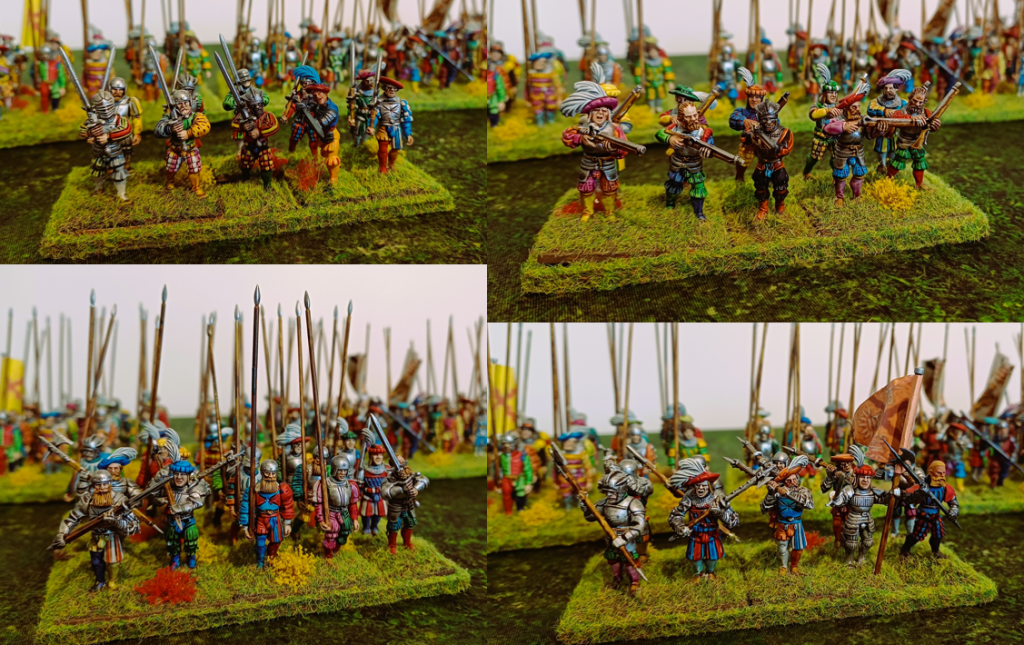
I tried to give a more or less accurate representation of how this would look on the battlefield. Now, this is where there’s some ambiguity about the strength and number of men in a pike block. The Swiss used flexible 100 men affairs, ten rows deep, with some halberdiers sprinkled in to fill up gaps or exploit gaps in the opposing lines. But there are records of larger formations and blocks of a thousand men or more. The typical Landsknecht company or Fähnlein consisted on paper of about 400 men, subdivided into “Rotten” or units if you will. The back ranks were made up of experienced or veteran troops. Banner bearers were put in the middle, as a rallying point and within easy shouting distance.
The pike blocks were supported by crossbowmen or hand gunners who would be deployed on the flanks, and skirmish ranks that would retreat into the mass of pikes when confronted with cavalry. The Doppelsoldner, literally “double paid” troops equipped with fearsome Zweihänder swords, were put at the front lines as forlorn hope, taking on the dubious task of breaking up enemy formations. As time went by, the unit sizes dwindled as much as the quality of the troops. More advanced black powder weapons heralded in the end of the pike block. By the thirty years war, musketeers dominated and pike blocks were still extensively used, but at the end of the conflict the last true landsknechts were gone. Training hundreds of people to execute complicated maneuvers in sync is very time intensive, loading and firing a musket less so.
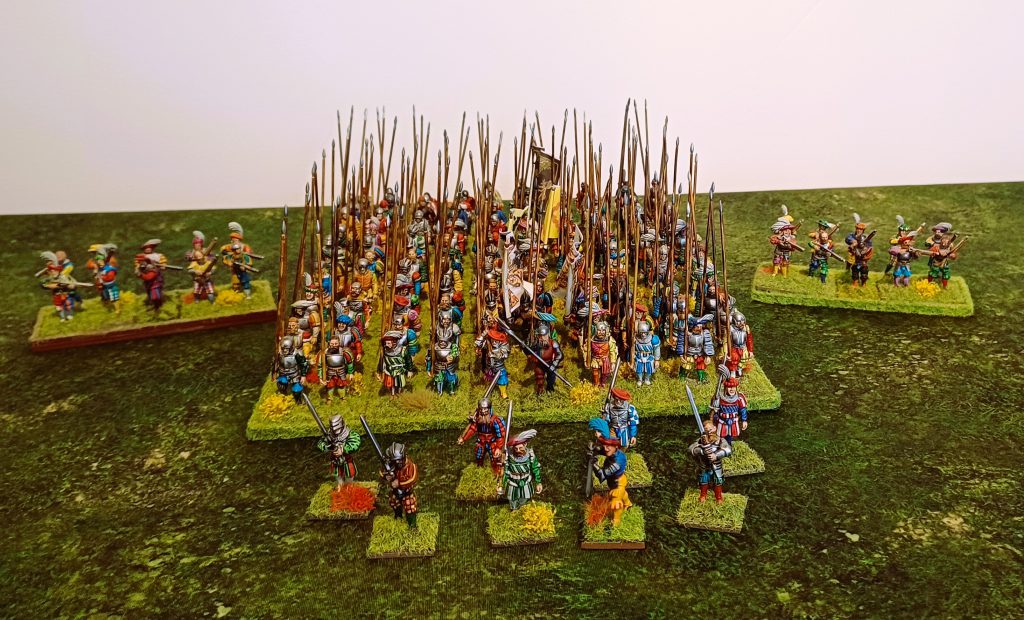
For modeling, this does bring up the basing question. I put most troops four to a 40x40mm base, with some individually based to remove casualties or to make it easier to put them on smaller movement trays. This works in most games, although I do use dice at times. In hindsight I could have just mass based them on the movement trays, but it works fine as is.
The more observant reader will have noticed I haven’t mentioned either the Perry miniatures or Italian side in this overview. The reason is because that side needs a bit more tender love and care before I can call it finished, and there’s a couple of books waiting in the queue as well. The army feels more or less complete on the Landsknecht side, I still learn and discover new things as I amass more books about the period. Some artillery would be nice, so I’m looking into that.
Since this is an army overview and the damage is already done, I guess there should be a recommendation in here somewhere. Personally, if you want to do something different and colorful, Landsknechts are perfect for a historical collection or army. Although it’s a pure Warlord models collection (who annoyingly haven’t brought out the attacking pikemen for some reason when they bought the range) it is an affordable way to bulk out those pike blocks. The models themselves look great en masse. That being said, I have my eye on Steelfist miniatures, who have been expanding their renaissance range. There are plenty of characterful sculpts out there to add variety to your army if you want to make some more individual front rank troops or leaders.
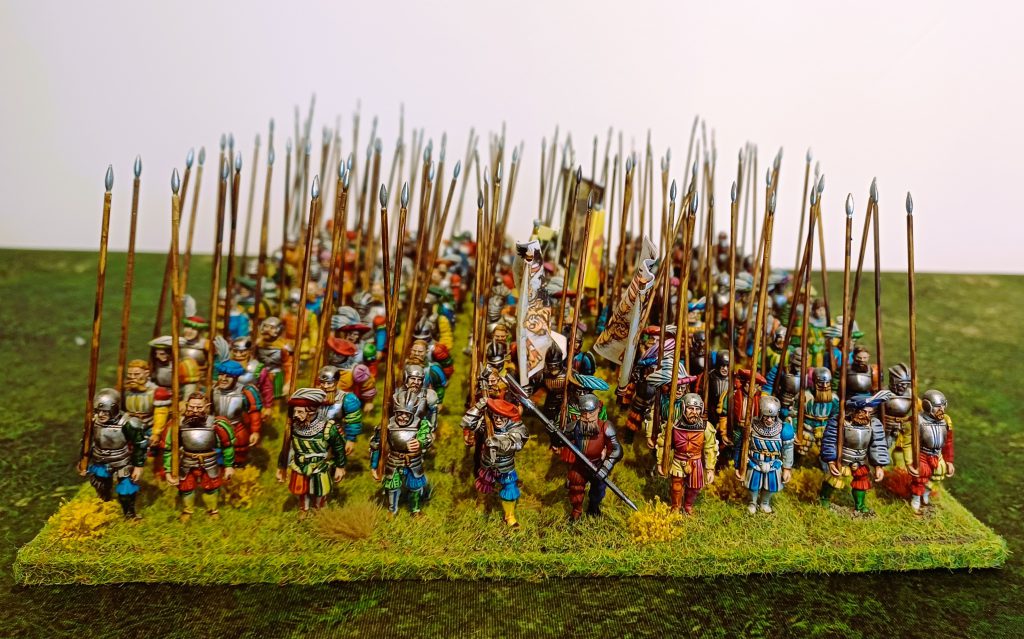
I struggled for a while to find a ruleset to cover this period that clicked with me. Lion Rampant is a good shout if you want the scale and gaming time manageable. However, Never Mind The Billhooks is my go-to to have games at the club now. It has a bit more period-specific rules for the period and is easy enough to use as a pick-up game system. Although I technically could use a bigger scale as well, I’d feel obliged to pad out those blocks again. That may be in the future somewhere.
I hope to return with a more in depth overview of the Italian side in an upcoming installment, and hope you enjoyed reading aboutmy little Landsknecht project!
Questions, comments, suggestions? Still sore about some Landsknechts skipping out your local siege in North Italy after they’d been paid? Contact@goonhammer.com or leave a comment below.
